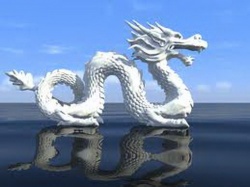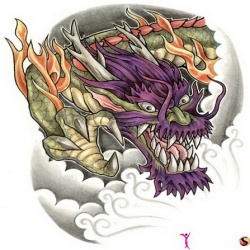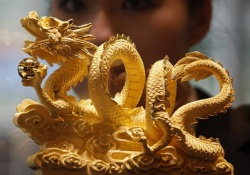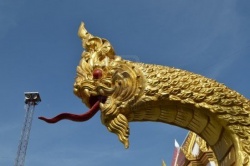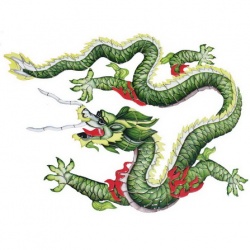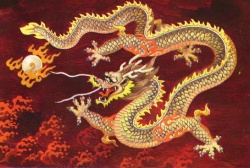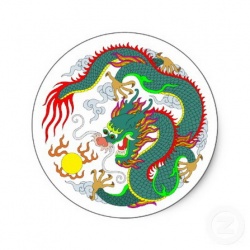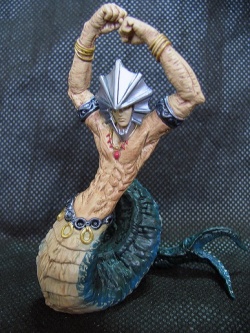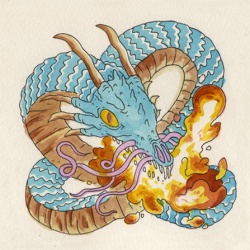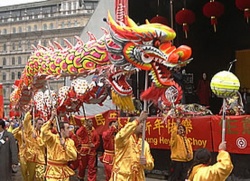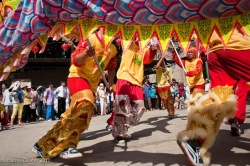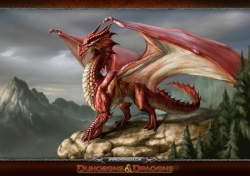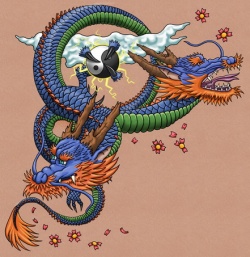Dragon as Naga
It may very well be that dragon is one of a number of ways that Western cultures refer to the Naga. Some hold though, that the word dragon actually refers to two entirely distinct beasts -- that the Western and the Chinese mythological beasts do not even belong to the same class.
The Chinese, when they encountered the term Naga in Buddhist scripture, translated it as lu or lung which means 'dragon' and so in China the ancient dragon concept took on a broader significance.
The Chinese dragon represents the vital potential of falling rain and flowing waters, unlike its western counterpart that sits brooding in a cavern guarding treasure. Joseph Campbell (The Power of Myth 150) describes the Asian dragon emerging from a swamp beating its belly and bellowing, "Haw ha ha haw!"
In Eastern mythology, Nagas are a class of being whose primary role is as protector and benefactor. Since their abode is the deep water, they are a source of Knowledge and of fertility but they also guard the immense riches of the Earth. Thus the Eastern dragon has mainly benevolent and auspicious characteristics but in Western mythology, the role of the dragon has been strictly curtailed rendering it into an ugly, greedy and jealous opponent of the Hero. It is the opinion of some that the reason for this has to do with the way people in the West view nature itself-- as something to be vanquished.
Mother Nature
The essence of Life in the Form of the dragon's celestial Breath is called in Chinese sheng chi. It is the source of all energy that contributes to fertility and Wealth such as the seasonal changes of the rain that allows crops to grow, the warmth of sunshine, balmy sea breezes and fertile soil. In fact, the dragon is the eastern Mother Nature.
In Himalayan Buddhism, a banner of a turquoise dragon stands for ". . . the Sound of Compassion that awakens us from Delusion and increases what we can know through hearing. Dragons have the Power of complete communication and protect one from slander." (~ Snow Lion Publications.)
Draco
In the era before this one, that is about 1, 800 BCE or around 4, 000 years BP [Before the Present] the celestial indicator or Pole star was not our North Star (Polaris) but Thuban a mid-point star in the constellation known as Draco or Dragon. Draco is the 8th largest of the conventional constellations curving from the "pointers" of the Dipper (Ursa Minor) to brilliant Vega. To the observer of today, there is no bright star in the configuration. Yet, the passages in the great pyramid at Gizeh, Egypt, once acted as channels for the Light of the star that is called Thuban. (It is now known that those pyramids were oriented to Orion and, at the time of the building of the Sphinx, to Leo.)
It has been demonstrated that the Angkor Wat complex, the great Khmer (Cambodian) Buddhist shrine, was built in alignment with this celestial formation. However, in 1,150 CE the constellation of the Dragon was upside down over the site's medieval buildings, but impressively, in the era of 10,500 BCE traces of the very earliest structures there mirrored the Dragon constellation exactly.
The transition from one ruling celestial system to another is marked in the mythologies of the World by accounts of the overthrow of Titans (Greek) or Ashuras (Indian) by Gods or Devas. Naturally, this displacement had to be justified, and so the serpentine heavenly Mother, Tiamat of the early Mesopotamians is considered by devotees of the newer deity, Marduk as an Evil draconian monster.
Greek Transition Myth
Gaia (Mother Earth) had given a Wish-fulfilling Tree as a Wedding present to Hera, bride of Zeus, and this tree produced wondrous fruit called the Golden Apples of the Hesperides (Daughters of the Western One -- the gentle reddish deity of sunset.) She decided to keep it where it grew and Ladon, the hundred-headed dragon/Naga was appointed to guard the fruit of this Tree of Knowledge against any thieves.
Now her stepson, Herakles (Glory of Hera) had to undergo 12 terrible trials as a result of a heinous murder he had committed, and one of the last was to steal the apples from the Virgin Mother, Queen of Heaven. {She renewed her virginity once a year at a sacred spring.]
With the help of the Titan Atlas, supporter of the Heavens, in exchange for relieving him of his enormous burden for just a few moments, Heracles shot arrows at Ladon as a diversion but then he struck and killed the dragon, and Atlas managed to fetch 3 of the golden apples. (Atlas was tricked into reclaiming his burden again when Herakles asked for a moment to adjust his position so that he could bear the weight a bit more comfortably. )
As for Ladon, Hera was distraught over its demise and did it great honour by placing it high in the night sky where it is coiled to this day.
Divine Ancestor
The flying dragon whose abode is the heavens is universally recognized as a Symbol of the Chinese culture and its people. Chinese refer to themselves as Lung-tik Chuan-ren, that is "Descendents of the Dragon."
It is believed that on rare occasions Dragons have the Power to transform themselves into handsome humans who, male or female, can mate with people. For example, former Japanese Emperor Hirohito [fl. 1940] claimed descent from Princess Fruitful Jewel, daughter of a sea Dragon King. It is this belief that lies at the root of the dragon as crest or emblem of a royal house.
A dragon depicted full face was the exclusive Imperial Symbol, but other kinds of dragon emblems were used by ministers and representatives of the Chinese emperor, such as the ambans or viceroys.Yu Pang was a peasant who rose to the highest rank and ruled China as its emperor. To legitimize this unheard-of accomplishment, he was the first to claim descent from a dragon. From that time onwards, Dragon-face was the Epithet used to refer to the ruler. Perhaps to encourage the notion that this was more than just a nickname, in Japan where the lifestyle owes much to China, the ruler adopted the practice of sitting concealed behind a bamboo screen during audiences with visitors.
Weather
The rains that fertilize the land were attributed to the actions of the Dragons, but so were the tremendous and devastating storms that sometimes occurred. These were attributed to the movements of the great celestial Dragons as they emerged in the spring or descended to their Caves in the autumn.
Mentor
The superior kind of Chinese dragon is said to have a great pearl in its throat which symbolizes its custody of Wisdom. (But also, a lunar eclipse.) It is believed that the Knowledge of Writing was given by a yellow dragon to legendary Emperor Fu Shi. This association of the dragon with the fertility of the intellect has a long tradition. We have seen that the historical Buddha during his Meditation under the Bodhi tree is believed to have been shielded from the elements by a many-headed Naga. In the long line of deities and saints described as having protection from this kind of serpentine creature is a 13th century Cambodian king. He is said to have spent his nights in a golden tower consulting with a nine-headed dragon. He could be accused of not heeding his advisor when there was a drought, flood or major storm. Dragons were Thought to be able to change size. When they were smaller, they could be the cause of minor watery annoyances such as dripping eaves or a leaky roof. On the other hand, according to a Tibetan Lama, on occasions such as a Dharma-teaching, the appearance of unexpected water as when a sink overflows or the basement leaks, is considered an auspicious sign -- the approval of the Nagas.
Panthaka is one of those numbered among Buddha's 16 Arhats. He was said to have possessed magic powers that were called upon when Buddha made an expedition to subdue and convert the fierce dragon-king Apulala. He could make himself smaller and smaller until he seemed to disappear. When he is shown among the other disciples, he is the one depicted charming a dragon into his alms-bowl.
Lung-chun or Dragon-host is the Chinese Form given for the Indian name that appears in that context. The dragon is the vehicle of Dorje Chang or Vajradhara, the Buddhist meditational deity. It is also the emblem of one of the Tibetan Buddhist schools descending from Milarepa. (The Garuda, the Snow Lion and the tiger are others.)
That is because the founder of the Dragon or Drukpa Lineage, Tsangpa Gyare, " . . . whose existence was in fact earlier predicted by the Dakinis (you know, some forms of Spiritual beings), while looking for a suitable site to build a proper place to spread the teachings of the holy lineage, met with nine Dragons. These auspicious creatures flew up into the sky, followed by a loud clap of roaring thunder. At this sight, Tsangpa Gyare decided to build his Monastery in this holy place then and there. Therefore, the first Monastery, ‘Nam Druk Sewa Jangchub Ling,’ was built, located not too far from Lhasa, the capital of Tibet.
Based on this remarkable incident, I think that was the first time the dragon was associated with our lineage. Then it became quite natural for the followers of this lineage, or for that matter, the lineage holder and the lineage itself to be called the ‘Drukpa’ or ‘Druk’ lineage. As you know, the dragon is supposed to be an important and auspicious celestial creature, and even Bhutan is commonly called ‘Drukpa’ or ‘Druk Yul,’ meaning the ‘Country of Dragon.’ The Bhutanese people also refer to themselves as ‘Drukpa,’ meaning people from the dragon country."
Guardian
The Chinese, Fa Hsien (394-414 CE) and 200 years later, Hsuan Chuang, both visited Shankashya one of the eight important places of Pilgrimage for Buddhists. It is the site of Buddha's descent from the Tushita Heaven and is reputed to be the place on Earth where all Buddhas descend. People told both pilgrims that there was a white-eared dragon living close to the Monastery which housed about 1,000 Monks and nuns. The dragon cared for the Monastery and the whole surrounding area. Fa Hsien's journal entry in particular emphasizes the abundant produce of the land, and the prosperity and Happiness of the people. In that case, we have the prototypical eastern type of dragon. It is generally benevolent -- the embodiment of divine protection, vigilance and fertility. In its Form that combines fish, reptile and bird it has the ability to swim in the seas, fly in the heavens and coil up in the land where its humped back forms the ridges of mountain ranges. Generous and kind, it wards off wandering Evil spirits and protects the virtuous and the innocent. Therefore children born in a dragon year of the 12-animal cycle especially are considered to enjoy health, Wealth, and long Life.
Medea, Mistress of Dragons
Greek mythology relates that once a king of Thebes, desperate to protect his kingdom from his nephew Jason, sent him off on a deadly mission: to journey across the sea far to the northeast to retrieve the Golden Fleece of Hermes' flying ram. (Sheep's fleece has been documented in western Asia today as still being used to filter and trap gold from mountain streams.) But this fleece, besides being of sacred origin, was also the totemic object bound to the longevity of the king of Colchis. It was protected there, not far from the Black Sea where it had been nailed to a tree in a dragon sanctuary.
Jason being regurgitated from the maw of the drakon of Colchis that guards the Golden Fleece.
Jason sought help from the foreign king's daughter, Medea, an adept of the cult of Hecate, the Moon goddess. Unfortunately for her, she had become the target of one of Eros' arrows and was smitten with Jason. When he promised before the deities of that Asian land to take her back with him to an honorable estate, i.e. as his lawful wife, she agreed to betray her own father and thus endanger the welfare of her state, to sing the dragon to sleep.
Jason accomplished his quest and returned to Greece with her, which must have taken some time for they had two sons together. When his uncle did not keep his part of the bargain, Jason and his family had to flee to Corinth. There, in an attempt to make a place for himself, he became involved in an arranged marriage with the daughter of Creon, ruler of that city.
Medea was appalled primarily by the broken sacred vow, and pretended to accept the situation making for the younger woman, a poisoned dress of cloth-of-gold. When that poor victim suffered her final agony, Medea then slew her own two sons before their father's Eyes. She conjured up a dragon-drawn vehicle and flew off in it as Jason fell upon his own sword on the threshold of their home.
Honouring the Dragon
From pre-historic times, monuments were raised and later, temples and shrines were built in honor of the Dragons that were understood to be controllers of the rain and the Wealth of rivers, lakes, and seas. For example, see an example of the vishap-k'ar, dragon stones of pre-Christian Armenia.
Incense and prayer were offered, especially on the first and fifteenth of every month, at pagodas and shrines such as Black Dragon Pool Chapel near Beijing said to have been reserved especially for the use of the Empress and her court.
Temple Island in Japan's inland sea is a famous dragon Pilgrimage destination. There are also lu temples in Tibet where various reptiles are also considered members of the Naga class of beings.
The Dragon Image
The dragon is one of the four Chinese Spiritual Animals. The others are the phoenix, qilin (a kind of unicorn) and the tortoise. As Protectors of the four directions or, cardinal points of the compass, they are: red bird, white tiger, dragon, tortoise. Much has been made of the distinguishing characteristics of the various Asian Dragons. There is an iconographic convention in which the common dragon is four-clawed, the five-clawed one is the celestial one that is the Chinese Imperial emblem, and the colonial type such as the Japanese one is shown with only three.
The image of a dragon, its face or mask (Skt.: mukha,) or an abstract design representing its serpentine Form is generally used as a protective mark. For example, the winding design used to frame the corners of a page of Tibetan Writing has its origin in Nagas or protective Dragons; sometimes their Eye dots are indicated. In the Tibetan tradition, the turquoise dragon is said to protect against discord of all types but especially slanderous gossip and the misuse of words. Dragons often appear on metal musical instruments such as bells, gongs and the small cymbals that can serve to represent the music Offering on a Buddhist shrine. This may relate to the roar of righteous indignation of the protective dragon but also to its legendary Love of music.
They are also often found in architecture where they protect against Fire and earthquakes. Their image functions as a kind of amulet or talisman of security so they are found at the bases of monuments, on Bridges and on the eaves of roofs.
Lifespan of the Eastern Dragon
While male Dragons are described as having undulating steep concave horns, female Dragons are said to have straight noses, round manes, thin scales (81 in number) and a strong tail. They lay their eggs near water and the eggs can take 1000 years to hatch. When fluid runs from the eggs as they begin to hatch, it is said that the parents cry out. The sounds of father and mother differ and they dramatically affect the weather in different ways causing darkness, torrential rain, and the essential thunder and lightning that induces the dragon eggs to crack.
The different forms of the dragon are attributed to its stage of development. At 500 years they are considered Kiao (scaled Dragons,) at 1000 years they are mature Lung. It takes another 500 years for the horns to develop fully- Kioh-lung- and another millennium for the dragon to fully develop into the Ying-lung or winged dragon capable of flight. They are believed to have shape-changing abilities except when being born, sleeping, lustful or angry.
There are four major kinds of Chinese dragon: t'ien lung, (celestial guardians) who support the mansions of the gods; shen lung (weather makers) who govern the clouds and bring rain; ti lung (Earth-dragon) who control rivers; and the fu-ts'ang lung (treasure keepers) who guard deposits and hoards of precious metal.
Dragons are said to like precious stones and roasted swallows but to be afraid of the leaves of the wang plant, leaves of the lien tree, 5-coloured silk thread, wax, iron and centipedes [scorpions?].
Classes of Dragons
There is a popular classification of Chinese Dragons that aims to identify 9 types. It lists: the horned dragon, the winged dragon, the celestial dragon supporting and protecting the mansions of the gods, the Spiritual dragon which generates wind and rain for the benefit of mankind, the dragon guarding concealed Wealth and the sinuously moving water dragon.
The most powerful is the horned dragon or Lung which produces rain and is believed to be totally deaf. It is described as having a head like a camel, horns like a deer, Eyes like a hare, ears like a bull, a neck like an lizard, a belly like a frog, scales like a carp, paws like a tiger, and claws like those of an eagle. The homeless dragon known as Ii lives in the ocean, and the Chiao is a scaly green creature with yellow sides and a crimson underbelly that inhabits marshes or mountain dens. It has a pair of large canine teeth in its upper jaw and long whiskers which it uses like those of a catfish. It can vary from greenish to golden and is said to have alternating short and long spines all the way down its back and tail, ending in a long brush.
"One specimen had wings at its side, and walked on top of the water. Another tossed its mane back and forth making noises that sounded like a flute. Cow-heads are also common. A ten-footer, found lying on the banks of China's Yangtze River, was different from most because of its long, thick eyebrows. A Yellow River variety, seen on shore in the 1920s by a Chinese teacher, was bright blue, and as big as five cows. Both Dragons crawled into the water as soon as it started to rain." The four directional Dragon Kings Form a distinctive type of Chinese dragon. In paintings, the red one is associated with the West, black is for the North, yellow for the Eastern one and green for the Southern one. When a central one is depicted, it is usually white, but may be blue.
Dragons are also Thought of as features of geography. For having brought rain to humankind without the Jade Emperor's permission, the troops of Heaven were ordered to arrest four rebellious Dragons and the Mountain God collected mountains with which to pin them down.
" Determined to do good for the people forever, they turned themselves into four rivers, which flowed past high mountains and deep valleys, crossing the land from the west to the east and finally emptying into the sea. And so China's four great rivers were formed -- the Heilongjian (Black Dragon) in the far north, the Huanghe (Yellow River) in central China, the Changjiang (Yangtze, or Long River) farther south, and the Zhujiang (Pearl) in the very far south."
Reversal of Fortune
A type of European dragon known as the guivre can cause disease with its Breath, but it has the curious characteristic of being so embarrassed by nudity that it will flee from the sight.
There is a legend that relates how Bishop St. Romain of Rouen subdued the gargouille: The sinuous monster emerged one day from the waters of the Seine and causes a great flood. The archbishop of Rouen accompanied by a volunteer, a prisoner who was slated to die, manage to confront the monster. The archbishop place one finger across another, making the sign of the cross, and the gargouille was immediately tamed. Sadly, tamed or not, it was led submissively to a place of execution where it was burned to Death.
The Western dragon is the diametric opposite of its Eastern counterpart. We can almost visit the time and the place where the transformation occurred. The scripture designated by its opening Babylonian words Enuma Elish describes how "gorgeous Tiamat" whose domain is the Earth's water is cruelly slain by Marduk. This Lord, the champion of the sky gods and titans, slays the dragon with a blow from his mace and a bag of Evil wind that he gets her to swallow so that she explodes. Her remains "like a clam shell" Form the heavens and Earth as we know it. King of the Indian devas, Indra, slays Vritra the water dragon also by means of a blow from the mighty mace.
Beowulf
As metal-working is refined, the spear and sword replace the mace or hammer. The skill of tempering blades moves west and the dragon, too, changes. In the Cotton-Vitelius manuscript #15 that was given the title Beowulf, a monster called Grendel periodically emerges from his deep marsh den to raid the darkened castle hall during the night. "Every nail, claw-scale and spur, every spike and welt on the hand of that heathen brute was like barbed steel." The tale is estimated by scholars to be from the 6th or 7th century CE, though the one surviving manuscript dates from around 1000. It tells how Grendel and his mother are killed by the Geat [Jut = southern Swede] hero, Beowulf. He and his men had come south from across the sea to aid the Danes, who for 20 years had been preyed upon, sometimes 30 at a time.
The 'Dragons' are described as "... huge marauders from some other World. One ... looks like a woman; the other, warped in the shape of a man, [but] bigger than any man, ... . They dwell ... on windswept crags ... where cold streams pour down the mountain and disappear under mist and moorland." but at night "the water burns." and when "the skies weep ... out of its depths a dirty surge is pitched towards the heavens."
There are three encounters with Grendel, and we learn that this monster does not conform to the standard dragon type. He is described as wanting to cram the men into "this roomy pouch ... intricately strung and hung at the ready, a rare patchwork of devilishly fitted dragon-skins." The dragon escapes, but loses his right "hand" which is pinned to the castle wall as a trophy. (When he is finally beheaded it takes 4 men to carry off the head.)
When the men visit the blood-tinged waters, they see "writhing sea-Dragons" and all manner of monsters. The hero goes into the water and it takes him all day to reach the lair at the bottom. He struggles with the ides aelwyf or "hideous alewife." That is, the monstrous eel-like Naga who is Grendel's mother, but she "pounced upon him and pulled a broad, whetted knife." Beowulf finally manages to cut off her head but only with an enormous sword from her own hoard.
The men have given him up for dead when after 9 hours he emerges, but his sword "began to wilt into gory icicles, to slather and thaw" from the effects of the dragon-blood so that only the golden hilt remained. The inscription on the hilt tells the tale of God's destruction of the giants that the 'ides aelwyf' is related to. Years later, from the depths of a barrow that someone had plundered came again "the slick-skinned dragon, threatening the night sky with streamers of Fire." It "rippled down the rock" and later "hurtled forth in a fiery blaze" that did "burn bright homesteads" so that Beowulf now an old man, goes forth once more.
Assisted by young Wiglaf, the dragon is stabbed to Death but it "caught the hero in a rush of flame and clamped sharp fangs into his neck." The hero gets to see its golden hoard but "The wound began to scald and swell" and he dies, the last the Geat warriors from over the sea. Before the Cremation of Beowulf, "The Fire-dragon ... scorched all colours." and measuring 50 feet from head to tail who had "shimmered forth on the night air once." is pitched unceremoniously over a cliff.
The poem ends with a Geatish woman singing a dirge "a wild litany of nightmare and lament" with predictions of invasion, "bodies in piles, slavery and abasement." The hoard along with Beowulf's remains are covered up in a great stone barrow that 12 warriors ride around singing the praises of the great and good Beowulf.
It was Professor J. R. R. Tolkien (famous for his Lord of the Rings trilogy) who first showed that the tale of Beowulf was more than a fictional work of entertainment. Though there are references throughout the poem of the Judeo-Christian World view, there are also allusions to the beliefs and customs of an earlier tradition. Surely the dire prediction at the poem's end is in some way related to the slaughter of the Dragons -- especially "Grendel's mother."
Saint George, a dragon-slayer along the model of the Beowulf of folk memory, is the patron of Russia, Greece and England (adopted by Edward III in 1348). The characteristic depiction showing a helmed knight on horseback spearing a recumbent dragon in defense of a lady appears in Uccello's painting ca. 1455.
- The legend of Cleodolinda and George
- Nov. 1883 Society of Antiquaries article on Dragon of St. George plus Edward Burnes-Jones' pre-raphaelite painting [not avail.]
- Reproduction of romantic St. George et al.
In mediaeval Christian Art, Michael the Archangel (usually depicted standing) slays the dragon under his feet that represents the Evil One a.k.a. the 'Old Serpent'. Michael's opponent is frequently also depicted as a man.
The Greek Cadmus is said to have sowed the ground with dragon's teeth from which sprang numerous ranks of armed men. The chariot of the Greek moon goddess, Cynthia, was drawn by Dragons.
Old Testament references to "Dragons" result from an error in translation of the Hebrew "tan" which means jackal but it was taken to refer to a giant water-serpent, as a consequence of its relation to the name Tanith, a Semitic (Phoenician and hence also Carthaginian) goddess ie. a Naga.
There are literally hundreds of dragon pages on-line ranging from the silly to the scholarly. This page is intended only to underline the fact that a Naga by any other name is still a Naga. When it flies, it is often referred to as a dragon.
The phrase 'Fire drake' that is, 'fiery dragon' was used to refer to comets especially as ill omens such as the one that is reported to have preceded the Battle of Hastings (1066) when the Normans successfully invaded England.
